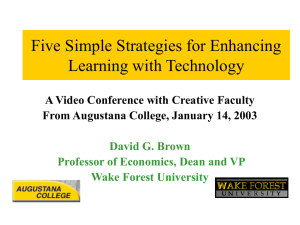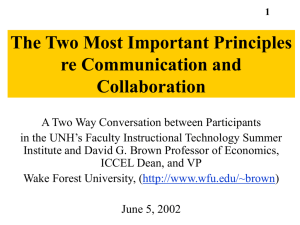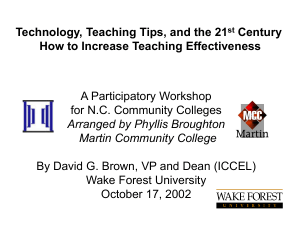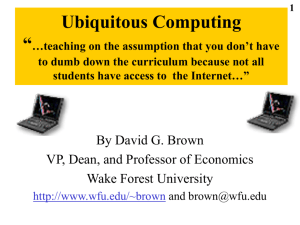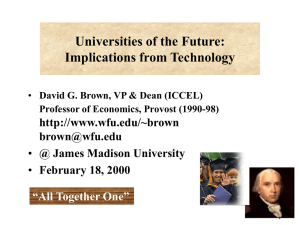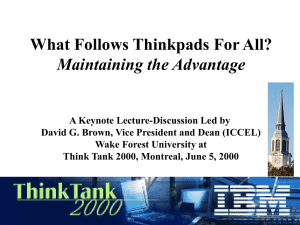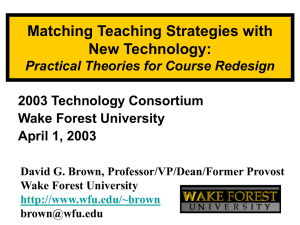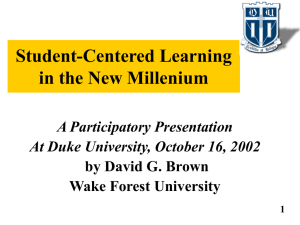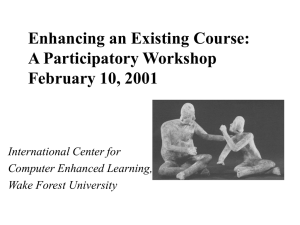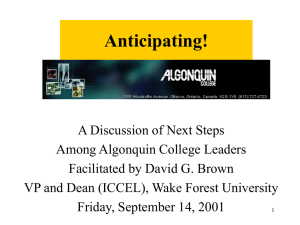Exploring the Impact of Technology on Teaching and Learning
advertisement
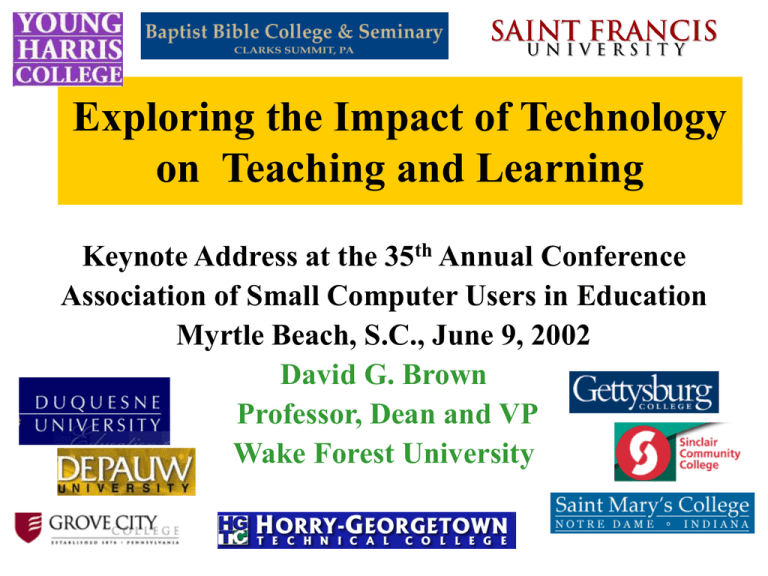
Exploring the Impact of Technology on Teaching and Learning Keynote Address at the 35th Annual Conference Association of Small Computer Users in Education Myrtle Beach, S.C., June 9, 2002 David G. Brown Professor, Dean and VP Wake Forest University How has the computer already changed teaching and learning? Please write down two phrases and share what you have written with a neighbor!!! "A computer lets you make more mistakes faster than any invention in human history--with the possible exceptions of handguns and tequila." --Mitch Ratliffe, "Technology Review" How has the computer changed teaching and learning? (my answer) 1. It’s caused every teacher to rethink & redesign. 2. By increasing student options, it has increased competition and compelled universities to pay more attention to the quality of teaching Our profession has been changed forever! How can we measure the influence of _________upon the quality of learning? Student Testimony Behavior Faculty Put a single letter in each box! E = excellent measure G = good measure P = poor measure Performance You may use the same letter in different boxes! However, make sure you use every letter at least once! Multi-Institutional Studies – Hu and Kuh (CSEQ data from 18,000+ students) http://epaa.asu.edu/epaa/v9n49.html – CSEQ Questionnaire http://www.indiana.edu/~cseq/overview.html and http://www.indiana.edu/~nsse/html/mbp/confra1.html – Brown (150 professors from 36 universities) http://www.ankerpub.com/books/brown.html – Flashlight Project of the TLT Group http://www.tltgroup.org/programs/flashlight.html Single University Studies – Wake Forest http://www.wfu.edu/Administrative-offices/InstitutionalResearch/michigan.pdf – Virginia Tech http://www.emporium.vt.edu/VisitorsWebsite/Article2.html – Seton Hall http://itd.shu.edu/links/index.htm – University of Central Florida http://pegasus.cc.ucf.edu/~irps/ – AAHE Assessment Forum http://www.aahe.org/assessment/ and http://www.aahe.org/teaching/tsk_frce.htm – Many, many other studies where 80—90% of students and faculty report that computers increase learning Research Results • University of Central Florida--Hybrid courses win! (the 80-20 rule) • 18,844 students at 71 American Universities--More “good practices” for wired students! • 150 professors at 50 Research Universities--Interaction, Collaboration, Debate, Custom, Adjuncts! • Virginia Polytechnic University--Calculus failure rate cut by 44%! • Seton Hall University--More self-exploration, contact, feedback, learning! Communication-Interaction Computers Enhance Teaching & Learning Via-Presentations Better--20% More Opportunities to Practice & Analyze--35% More Access to Source Materials via Internet--43% More Communication with Faculty Colleagues, Classmates, and Between Faculty and Students--87% ICCEL ICCEL --- Wake Wake Forest Forest University, University, 2002 2002 Computers allow people---• to belong to more communities • to be more actively engaged in each community • with more people • over more miles • for more months and years • TO BE MORE COLLABORATIVE ICCEL -- Wake Forest University, 2002 FIRST YEAR SEMINAR The Economists’ Way of Thinking: • To understand a liberal arts education as an opportunity to study with professors who think by their own set of concepts • To learn how to apply economic concepts • To learn how to work collaboratively • To learn computer skills • To improve writing and speaking Students = 15 All Freshmen Required Course Before Class During Class. After Class Brown’s First Year Seminar • Before Class – Students Find URLs & Identify Criteria – Interactive exercises – Muddiest Point – Lecture Notes – E-mail dialogue – Cybershows • During Class – – – – One Minute Quiz Computer Tip Talk Class Polls Team Projects • After Class – – – – Edit Drafts by Team Guest Editors Hyperlinks & Pictures Access Previous Papers • Other – – – – – – Daily Announcements Team Web Page Personal Web Pages Exams include Computer Portfolio Materials Forever ICCEL -- Wake Forest University, 2001 Reasons 150 Professors Added Computer Enhancements 1. Communication-Interaction 2. Collaboration-Teams 3. Controversy-Debate 4. Customization-Diversity 5. Consultants-Adjuncts The Millennium Context • • • • • • • Personal. Customized. Interactive. Student-Centered Curriculum & Databases Teams of Professionals to Support Learning “Houses” instead of Disciplines Blended Courses (80-20 and 20-80) Loose-leaf Collections of Course Chunks Internet Savvy Students (Nintendo) Low Hanging Fruit [within the constraints of time & money] 1. URLs 2. Email 3. Course Management System Better 85% Some Use Vs 5% Heavy Use The Good News for Small Colleges is that the Highest Benefit uses of the computer are among the Least Costly. • • • • • • Don’t Fear Distance Learning (Blended Wins) Pursue the Low Hanging Fruit (Email, URL, CMS) Teach on the Assumption of Internet Access Declare a Standard Hire Students Promote Information Fluency Student Teacher •My.yahoo •Custom learning team •Custom delivery •Custom learning resources Student-Centered Learning in the New Millennium David G. Brown Wake Forest University Winston-Salem, NC 27109, USA 336-758-4878 email: brown@wfu.edu http//:www.wfu.edu/~brown fax: 336-758-4875 Wake Forest University, 2002
